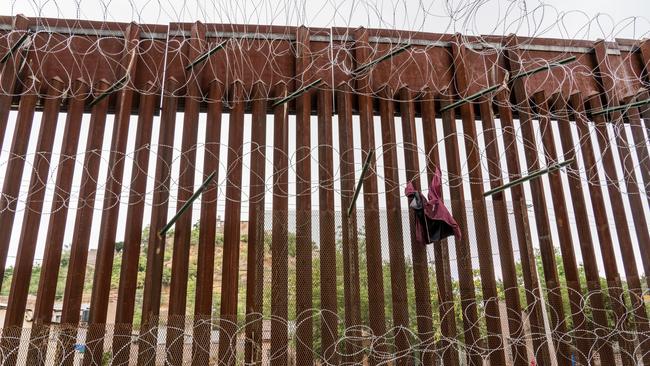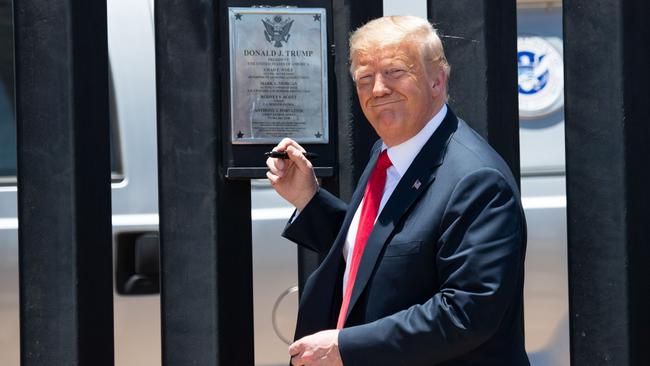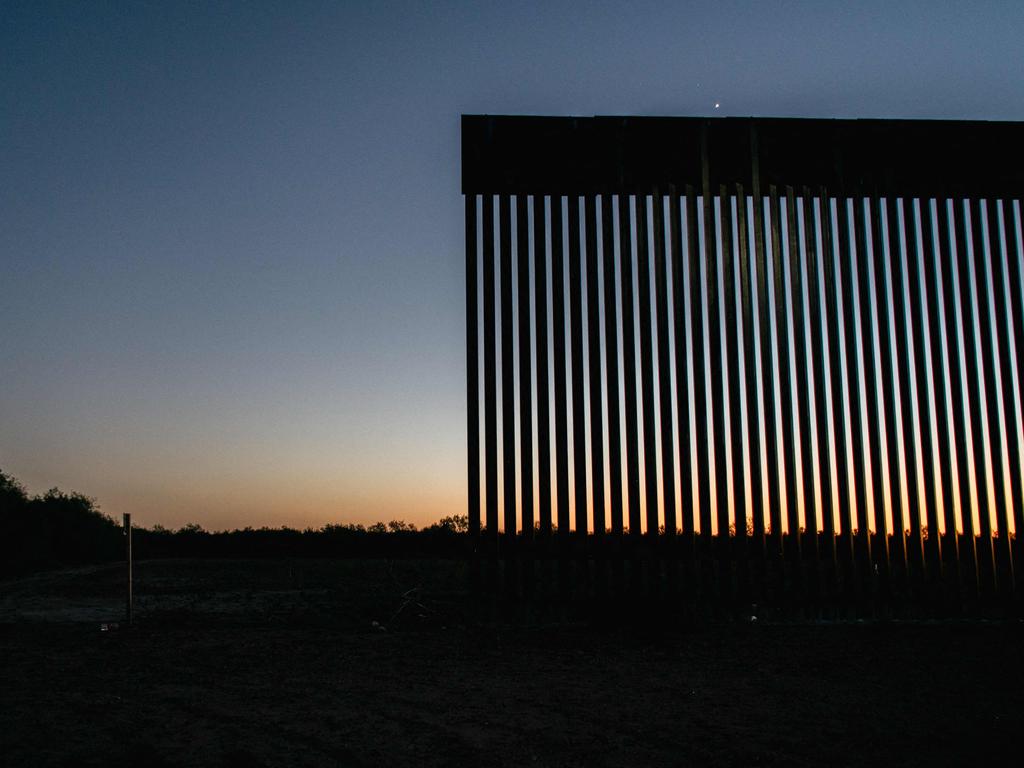Human tidal wave an epic tragedy of death and despair
Border crisis shows little sign of abating where Nogales, Mexico and Nogales, Arizona meet.

Seen through the iron gate from Nogales, Mexico, giant Burger King and McDonalds signs dominate the skyline of Nogales, Arizona, above quiet, tidy streets of modern cars and better dressed pedestrians, symbols of the life that awaits any migrant who can overcome a 10m iron wall covered with barbed wire and then make a run for it.
“You’ll see one or two people jumping over and running as fast as they can to cars, it’s seconds to minutes. If you don’t catch them right away, then they are definitely gone,” Alan Regalado, a federal border agent with 10 years’ experience around Nogales, Arizona, tells me.
Just wait long enough and you’ll see someone drop over, several locals on the American side told me.
Perhaps I’ve cruelled my chances trying. “They wait until the right moment to cross, when no one is watching. Border patrol is not there all day, all night. The wall helps but it’s not foolproof,” Regalado says.
Nogales is the biggest US town on the Arizona-Mexico border, and it’s a giant funnel through which about 6000 trucks a day deliver Americans a vast array of produce and manufactured goods, including two-thirds of their winter vegetables.
Commerce, of course, isn’t the only industry.
Two massive concrete border checks puncture the wall, teeming with US federal border agents. There are 3700 in American Nogales, a town with a population of about 20,000.
The US southern border crisis is more than a political ulcer for Joe Biden and the ruling Democrats. A relentless focus of media reporting, it’s an epic humanitarian tragedy of death, despair and unfulfilled hopes, with no obvious solution and little sign of abating.
In November last year 172,620 people crossed the US-Mexico border without authorisation, according to US officials, as part of a 1.9 million human tidal wave during the previous 12 months, almost triple the number of each of the preceding two years. By contrast, about 50,000 people arrived in Australia by boat between 2009 and 2013.
“It’s f..king horrible down there,” James Holeman, a former US marine, tells Inquirer.
His volunteer group, Battalion Search and Rescue, established three years ago, brings together other veterans and emergency room nurses from around the country in a mission to save migrants lost in the desert and to try to reunite distressed migrants with their families.
“Dudes from California, all gringos, come over and work their arse off once or twice a month, blue-collars, landscapers, they drive six to eight hours and we hike all weekend,” says Holeman, 56. “It gives families and loved ones peace and closure.
“Imagine your dad had to leave and you never heard of him again. Did he die, remarry? Does he not love me any more?”
Arizona Department of Homeland Security director Tim Roemer says about 300,000 people were apprehended on the Arizona border, about 20 per cent of the total across the entire 3142km US-Mexico border, about the distance from Melbourne to Cairns, last year.
“But we catch only about 35 to 50 per cent, although border patrol guys say it’s a bit higher,” Roemer says. Texas, to the east, snares the lion’s share.
It’s massive business, with powerful incentives. The Arizona government estimates would-be immigrants pay about $US3bn ($4.19bn) a year in fees to the handful of gangs that control the flow of human traffic across the border.
“I’m not talking about drug-trafficking money, this is just the human smuggling part; they are charging anywhere between $5000 and $12,000 per person,” Roemer tells Inquirer.
Such a lot of money for poor people, I say. “If they can’t pay it all they get into indentured servitude to varying degrees. Women arrive with multiple morning-after pills because they know how many times they’ll be raped on the journey,” he says.
These hundreds of thousands of people seeking a life in the US vary widely in their backgrounds and desires.
Most of the crossers near Nogales are single men who don’t want to be apprehended, hoping for a better life of illegal work in the US.
“At the Yuma entry, you’d be amazed how many families coming in are actually fairly wealthy,” Roemer says, referring to the western border check of the state, where whole families typically turn up and claim asylum, availing themselves of the nearby international airport of Mexicali, an hour’s drive away.
The gangs have highly sophisticated operations, with advanced binoculars and communication devices, where scouts shuffle human cargo across the border at the times they are least likely to be caught.
Those who aren’t apprehended can face a grisly fate. Migrants are marked with wrist bands of different colours that designate to which gang they have paid their fees to cross.
“And if you don’t have the right band, or none at all, they just kill you,” Holeman says – if they haven’t starved already.
“We’ve found close to 100 human remains, from a single bone or complete skeleton to a guy that just died an hour ago. One weekend we found 12. This is the richest country in the world. People dying every single day,” he says.
“We geotag the site, mark with high-vis tape. And we photograph. And then we contact law enforcement, and we make sure they know about, but they don’t want to respond.”
Harvard economist Daron Acemoglu made Nogales famous in his book Why Nations Fail, which analysed how two groups of culturally identical people (everyone, unfortunately for me, addressed me in Spanish on both sides of the border) could have such disparate outcomes.
A city divided by a wall is the closest thing economists get to natural experiment.
Acemoglu put the difference down to the superior institutions of the US, which foster economic growth and wellbeing, with those of the corrupt practices Mexicans have inherited, along with the rest of South America.
Indeed, Nogales, Sonora isn’t the Mexico of Cancun or Tulum. With a population of about 230,000, about 10 times that of Nogales, Arizona, it’s pressed up against the wall with US as if its people can smell the opportunity on the other side. Americans cross back and forth each day in their thousands, walking or driving, for shopping, to visit family, or to bring food and essentials to the poverty-stricken families on the other side.
They power its economy, too. Their new braces gleaming, US-based sisters Fernanda and Danielle Villagrana, 26 and 29, of Mexican heritage, emerge from the Mexican side, trumpeting the discount dental work.
“We come down from Tucson once a month, we come get our braces done. It’s about half the price here, $US1500,” they tell me.
“It’s wrong because if you see the bigger picture Arizona was Mexico, so I don’t think it’s right, it was our land to begin with,” Danielle Villagrana says when I ask her about the border situation.
In a war in the 1840s, Mexico lost a third of its territory to the US, including nearly all of present-day California, Utah, Nevada, Arizona and New Mexico.
The Mexican side is dominated by pharmacies, doctors and dentists with English signs offering prices a fraction of what Americans will pay at home.
My passport about to expire, I was worried I wouldn’t be allowed in, given Mexico’s rules that passports need six months remaining. But no one even checked. There wasn’t a single Mexican official at either of the two gigantic concrete border checks, Mariposa and Deconcini.
Come on down and spend, is the clear message.
The border agent Regalado dissuaded me from trying to speak to people who might be trying to cross illegally.
“If they see a reporter coming over to them, remember the gangs see these people as their product, and you could ruin their transaction – it’s another world over there. We definitely can’t guarantee your safety,” he says.
Indeed, the packed streets of shoddy buildings, stray dogs, even a few donkeys, and street peddlers, made American Nogales, no Palm Springs itself, seem positively luxurious.
Some confusion about my visa on the way back meant I had to wait for an interview with border security. I asked the young man waiting with me why he’d been held up too.
“They know I’ve been shot twice before in a gang war,” he said, recounting a lucky escape from a local casino five years ago.
Kieran Halloran, a young Jesuit priest in training, welcomed me to the church-run Kino Initiative shelter on the isolated Mariposa entry to Mexico on the western side of the city, built up a few years ago near where US agents used to drop off migrants.
“There’s a big difference between what is actually communicated and what people hear,” he says when I ask him what is causing the human tidal wave. “Illegally is the only option they have. People have been stopped from the beginning of the pandemic, so you just have this backlog of folks wanting to move,” he adds, although he concedes the Biden administration could have created the “wrong impression”.
At the start of the pandemic the Trump administration used part of a little-known public health law from the 1940s, known as Title 42, to shut down asylum applications and eject applicants at the border, under the pretence of keeping Covid-19 out of the US.
In normal times the US is obliged by law to assess the asylum claims of all border arrivals.
Campaigning for the presidency, Joe Biden fuelled hopes he would reverse Title 42. He criticised the callousness of the policy, and in office relaxed Title 42 for unaccompanied minors, which has prompted tragic scenes of children being dropped over walls by desperate family. Families, if they had been vaccinated, could have their claims heard too.
Nine years into his training, Halloran, a the New Yorker fluent in Spanish, dismisses the idea much has changed at all in practice.
“We had families who were Mexican citizens with a case for asylum, we got them Covid tested, and they went up to present themselves and ask for asylum, here at the main gate in Deconcini, and the border agents literally closed the gate on them,” he says.

Trump made the southern border wall controversial, but building a wall has been a bipartisan policy in the US since Bill Clinton began building the wall around San Diego and El Paso in 1994, even if Democrats typically say they support only a fence.
Politically popular, the Bush and Obama administrations built about 565km of border wall. The Trump administration in fact extended only 84km of fencing in areas where none had existed before.
Asked what an optimal US border policy might be, Halloran pauses.
“I studied international relations, but for me it’s not so much about the policies now, but here are five kids in a shelter and their mothers, who I’ve gotten to know and love and adore, here are people who has suffered immensely,” he says.
The Democrats argue, as did Labor in Australia in 2008, that “push factors” are driving the surge: the pandemic has led to economic and social chaos in Central America, prompting families to seek a better life.
“The state of Guerrero has a lot of violence, people are fleeing, we’ve had times when we were getting whole towns of people coming up,” Halloran says.
“People are very upfront about their plight.”
Republicans, whose supporters put the border crisis among their top policy priorities ahead of this year’s mid-term elections, say the Biden administration’s policy changes are to blame.
Texas governor Greg Abbott began extending the wall across his state last month.
In Arizona, Republican Attorney-General Mark Brnovich, who is running for the Senate, has promised to crack down on illegal immigration along similar lines, linking the human trafficking to drug cartels that make billions from exporting everything from cocaine to fentanyl into the US.
Last year Arizona, which is also the gateway for illicit drugs into the US, seized 9.3 million pills of fentanyl, each enough to kill a human.
“It’s our Americans’ insatiable appetite for drugs that fuels these cartels, it’s all demand,” Holeman says, upset about the popular link between humans desperate for a better life and the drugs that have fuelled an overdose epidemic in the US.
Decades of wall building and a booming border security apparatus patently haven’t stopped the flood of people into the US.
It’s as if no government, even as powerful as the US, can foil the plans of desperate people to seek a better life.
That is, after all, how the US itself was founded. “It’s complex as hell,” Holeman says.



To join the conversation, please log in. Don't have an account? Register
Join the conversation, you are commenting as Logout